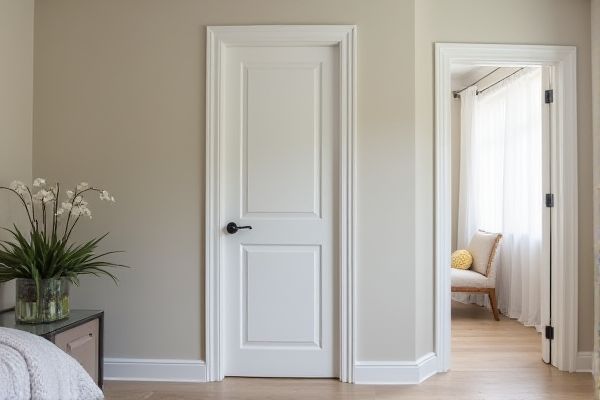
Concealed hinges offer a sleek, modern look by hiding the hardware within the door frame, enhancing closet aesthetics and providing smoother operation, while exposed hinges create a more traditional, decorative appearance that can add character and are easier to adjust or replace. Explore the rest of the article to discover which hinge type best suits your closet door needs and style preferences.
Table of Comparison
| Feature | Concealed Hinge | Exposed Hinge |
|---|---|---|
| Visibility | Hidden when door is closed | Visible on the door surface |
| Installation | Requires precise mortising | Simple surface mounting |
| Aesthetics | Clean, modern look | Traditional or decorative style |
| Adjustability | 3-way adjustment (height, depth, side) | Limited or no adjustment |
| Durability | Strong and durable, less exposed to damage | Prone to wear and damage from exposure |
| Cost | Higher cost due to complexity | Generally lower cost |
| Accessibility | Harder to access for maintenance | Easy to access for repairs and maintenance |
| Common Use | Modern closets, frameless doors | Traditional closets, framed doors |
Introduction to Concealed and Exposed Hinges
Concealed hinges, commonly used for closet doors, offer a sleek, modern aesthetic by remaining hidden from view when the door is closed, enhancing the room's clean lines and minimizing visual clutter. Exposed hinges, visible on the door's exterior, provide a traditional and decorative element that can complement a variety of interior styles while allowing for easier adjustments and maintenance. Choosing between concealed and exposed hinges depends on your desired blend of functionality, style, and the overall design of your closet doors.
Aesthetic Differences: Concealed vs Exposed Hinges
Concealed hinges offer a sleek, modern look by hiding the hardware entirely within the door and frame, enhancing your closet's clean and minimalist aesthetic. Exposed hinges, visible on the exterior, provide a more traditional or rustic charm with decorative designs that can complement various interior styles. Choosing between concealed and exposed hinges affects not only the visual appeal but also the design coherence of your closet doors.
Installation Process: Concealed Hinge vs Exposed Hinge
Concealed hinges require precise drilling and alignment within the door and frame, often needing specialized tools for installation, ensuring a flush and hidden appearance. Exposed hinges are simpler to install, with surface mounting that only requires screws and basic tools, allowing for quicker and more adjustable setup. The complexity of concealed hinge installation provides a cleaner aesthetic but demands more expertise compared to the straightforward process of exposed hinge mounting.
Space Efficiency: Which Hinge Is Best for Closet Doors?
Concealed hinges maximize space efficiency in closet doors by allowing the door to close flush with the frame, eliminating gaps and providing a sleek, streamlined appearance ideal for tight spaces. Exposed hinges require extra clearance as they extend beyond the door edge, potentially reducing usable closet space and creating obstacles in narrow rooms. For optimizing interior closet dimensions and achieving a neat, unobtrusive look, concealed hinges are the preferred choice.
Durability and Maintenance: Comparing Hinge Longevity
Concealed hinges offer superior durability due to their protected position inside the door, reducing exposure to dust and moisture that can cause wear. Exposed hinges are more prone to rust and damage since they are fully visible and directly exposed, requiring more frequent maintenance to sustain functionality. Your choice should consider that concealed hinges generally provide longer longevity with minimal upkeep compared to the more maintenance-intensive exposed hinges.
Cost Comparison: Concealed vs Exposed Hinges
Concealed hinges typically cost between $5 to $15 per hinge, offering a sleek, modern look ideal for contemporary closet doors, while exposed hinges range from $2 to $8, providing a more traditional aesthetic at a lower price point. Installation complexity and durability also influence overall cost, as concealed hinges require precise fitting and may involve higher labor expenses. Opting for exposed hinges can reduce upfront costs and ease maintenance but may compromise the clean appearance that concealed hinges deliver.
Adjustability and Alignment Features
Concealed hinges offer superior adjustability with multi-directional screws allowing precise alignment of closet doors horizontally, vertically, and in depth, ensuring seamless door operation and flush fits. Exposed hinges typically provide limited adjustability, often requiring shimming or manual repositioning for alignment, which can result in less precise door placement. The advanced adjustment features of concealed hinges contribute to enhanced functionality and a cleaner aesthetic compared to the more basic alignment capabilities of exposed hinges.
Accessibility and Functionality in Closets
Concealed hinges in closet doors offer superior accessibility by allowing full door opening angles, enabling easier access to the entire closet interior without obstruction. These hinges provide smooth, soft-closing functionality that reduces noise and wear, enhancing the overall user experience. In contrast, exposed hinges may limit door movement and can interfere with seamless operation, making concealed hinges a preferred choice for maximizing closet accessibility and functionality.
Modern Interior Design Trends: Hinge Preferences
Concealed hinges are favored in modern interior design trends for closet doors due to their sleek and minimalistic appearance, seamlessly blending with surfaces and enhancing clean lines. Exposed hinges, while more traditional, add a decorative element that complements industrial or rustic styles, offering visual interest through hardware finishes. Your choice between concealed and exposed hinges significantly influences the overall aesthetic, making it essential to align hinge style with your interior design vision.
Choosing the Right Hinge for Your Closet Doors
Concealed hinges offer a sleek, modern look and allow for smooth, adjustable door alignment, making them ideal for seamless closet designs where aesthetics are a priority. Exposed hinges provide a traditional, robust appearance and are easier to install and maintain, suitable for rustic or industrial-style closets. Selecting between concealed and exposed hinges depends on the desired visual style, door thickness, and ease of maintenance for your closet doors.
 homyna.com
homyna.com